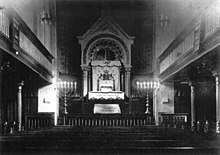Old Synagogue (Elberfeld)
The Old Synagogue was from 1865 to 1938 the meeting house of the Jews in Elberfeld (1929 neighborhood of Wuppertal ), until the construction of Barmer synagogue in 1897 it also served the Jews Barmen as a synagogue.
history
The number of Elberfeld Jews grew from 56 to 1664 between 1812 and 1900. The meetings and common prayers were held in private settings in various prayer houses at the beginning of the 19th century. Attempts to found a regular congregation with a board of directors and an employed rabbi failed again and again. In 1847 the law on the conditions of the Jews came into force, which in § 41 prescribed the ordinary election of a community council for all Jewish communities. Then on January 29, 1852, 27 Elberfelders and 10 Barmer men founded the synagogue community in Elberfeld-Barmen. In 1863, the community acquired a piece of land on Frugsamkeitsstrasse from the merchant Johann Hermann Opterbeck to build a synagogue with an attached school. The architects Hermann Ende and Wilhelm Böckmann received the order for the design , the building was erected in 1864–1865 and inaugurated on September 15, 1865 with the entry of the Torah scrolls and their placement in the shrine .
Only a few documents have survived on the architecture of the building; the precise shape of the building can no longer be traced today. One suspects a three-aisled hall, the central nave around 1.5 m higher than the side aisles over which the women's galleries were located. The room had the basic dimensions of about 16 by 12 meters. A slightly higher central projection emerged from the three-part entrance facade with three large round windows , which was crowned by an open, tower-like lantern. The length of the ship corresponded to five window axes on the long sides.
Larger alterations were apparently carried out in 1875, mainly for the technical renovation and the installation of a pulpit and an organ gallery. After the turn of the century, despite the separation of the Jews from Barmer, the community, which grew larger and larger, started planning a larger new building, the construction of which was apparently prevented by the events of the First World War.
At the beginning of the 20th century, Rabbi Joseph Norden and Cantor Hermann Zivi worked in the Jewish community of Elberfeld .
The Elberfeld synagogue , like all other Jewish buildings in Wuppertal, was set on fire and destroyed in the early morning hours of November 10, 1938, during the Reichspogromnacht . In a trial between 1948 and 1949, the essential role of the fire brigade in setting the fire was documented.
After the Second World War, the Jewish community of Wuppertal, which was re-established in 1945, used the former dining room of the old people's home in Friedrich-Ebert-Straße (formerly Königstraße), which was founded in 1913 and which was returned to it in 1959, as a synagogue.
Commemoration
In 1962, a memorial plaque was placed on the abandoned site of the Old Synagogue. In 1994, with the new building of the Old Synagogue Wuppertal, an exhibition and meeting center was created that researches and documents the history of the Jews in Wuppertal and the surrounding area. Granite slabs in the floor and remains of the wall outside indicate the location of the old synagogue.
It was only with the construction of the Bergische Synagoge in Barmen in 2002 that the Jewish community in Wuppertal and the surrounding area, which had grown to over 2,000 members after the collapse of the Soviet Union , received a large, representative church again.
See also
literature
- Ulrike Schrader : Torah and textiles. On the history of the Jews in Wuppertal. Wuppertal 2007, ISBN 978-3-9807118-9-0 .
Web links
- Entry in the Wuppertal soil monument list
Coordinates: 51 ° 15 ′ 33.5 ″ N , 7 ° 8 ′ 39.8 ″ E


